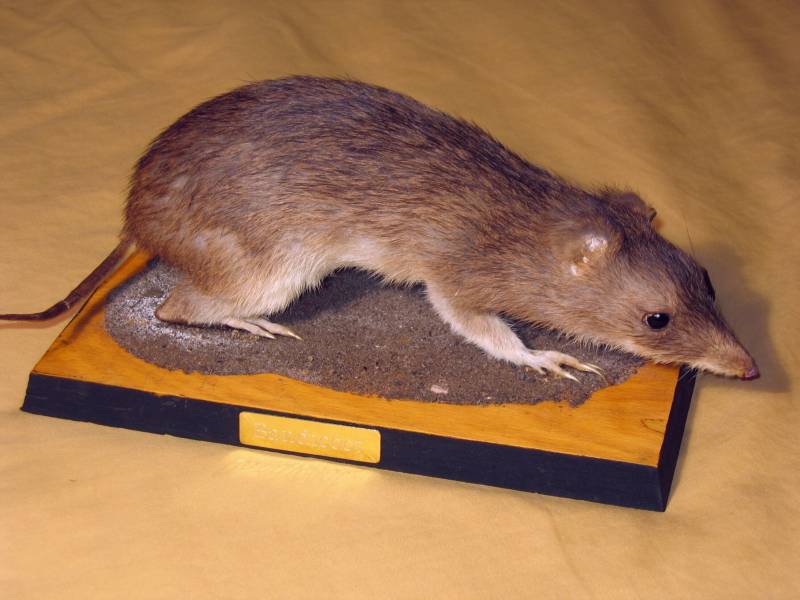- Peramelemorphia
Taxobox
name = Peramelemorphia
fossil_range = LateOligocene - Recent

image_width = 250px
image_caption = ashort-nosed bandicoot ("Isoodon" spp.)
regnum =Animal ia
phylum = Chordata
classis =Mammal ia
infraclassis =Marsupial ia
ordo = Peramelemorphia
ordo_authority = Ameghino,1889
subdivision_ranks = Families
subdivision =Thylacomyidae †Chaeropodidae Peramelidae The order Peramelemorphia includes thebandicoot s and bilbies: it equates approximately to the mainstream of marsupial omnivores. All members of the order are endemic to the twin land masses ofAustralia -New Guinea and most have the characteristic bandicoot shape: a plump, arch-backed body with a long, delicately tapering snout, very large upright ears, relatively long, thin legs, and a thin tail. Their size varies from about 140 grams up to 2 kilograms, but most species are about the weight of a half-grown kitten: somewhere around one kilogram.Evolutionary relationships
The position of the Peramelemorphia within the marsupial family tree has long been puzzling and controversial. There are two morphological features in the order that appear to show a clear evolutionary link with another marsupial group: the type of foot, and the teeth. Unfortunately, these clear signposts point in opposite directions!
All members of the order are polyprotodont (have several pairs of lower front teeth)—in the case of the Peramelemorphia, three pairs. This suggests that they have evolved from the
Dasyuromorphia (marsupial carnivores). On the other hand, they also have an unusual feature in their feet: the second and third toes are fused together. This condition is called "syndactyly", and is characteristic of theDiprotodontia (the order of marsupial herbivores that includeskangaroo s,wombat s,possum s, and many others).Attempts to resolve this puzzle include the view that the bandicoot group evolved from the carnivores, retaining the polyprotodont dentition, and independently evolving a syndactyl hind foot; the contrary view that syndactyly is so unusual that it is unlikely to have evolved twice and therefore the bandicoot group must have evolved from a possum-like diprotodont creature, and re-evolved its extra teeth. A third view suggests that the bandicoot group evolved from a primitive carnivore, developed the syndactylous hind foot as a specialisation for climbing, and the diprotodonts then split off and evolved the two-tooth jaw that gives them their name. Recent molecular level investigations do not so far appear to have resolved the puzzle, but do strongly suggest that whatever the relationship of the bandicoot group to the other marsupial orders may be, it is a distant one.
Classification
To provide context, the table below also shows the other major branches of the Australasian marsupial tree.
* Order
Microbiotheria : (1 species, theMonito del Monte of South America)
* OrderDasyuromorphia : (marsupial carnivores, 71 species in 3 families)
* ORDER PERAMELEMORPHIA:bandicoot s and bilbies (20 extant species, 3 extinct)
** FamilyThylacomyidae : (bilbies, 1 extant species, 1 extinct)
** Family †Chaeropodidae : (Pig-footed Bandicoot, 1 extinct species)
** FamilyPeramelidae : (bandicoots, 19 extant species, 1 extinct)
*** SubfamilyPeramelinae
*** SubfamilyPeroryctinae
*** SubfamilyEchymiperinae
** Superfamily †Yaraloidea
*** Family †Yaralidae: (2 described fossil species)
* OrderNotoryctemorphia (2 species ofmarsupial mole )
* OrderDiprotodontia (about 117 species in 11 families, including theKoala ,wombat s,possum s,rat kangaroo s,kangaroo s, wallabies and others.)References
*MSW3 Groves|pages=38-42
Wikimedia Foundation. 2010.
